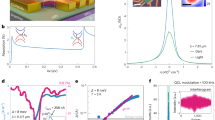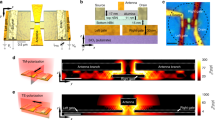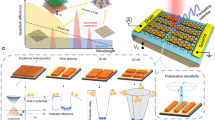Abstract
Quantum geometric properties of Bloch wave functions in solids, that is, Berry curvature and the quantum metric, are known to significantly influence the ground- and excited-state behaviour of electrons1,2,3,4,5. The bulk photovoltaic effect (BPVE), a nonlinear phenomenon depending on the polarization of excitation light, is largely governed by the quantum geometric properties in optical transitions6,7,8,9,10. Infrared BPVE has yet to be observed in graphene or moiré systems, although exciting strongly correlated phenomena related to quantum geometry have been reported in this emergent platform11,12,13,14. Here we report the observation of tunable mid-infrared BPVE at 5 µm and 7.7 µm in twisted double bilayer graphene (TDBG), arising from the moiré-induced strong symmetry breaking and quantum geometric contribution. The photoresponse depends substantially on the polarization state of the excitation light and is highly tunable by external electric fields. This wide tunability in quantum geometric properties enables us to use a convolutional neural network15,16 to achieve full-Stokes polarimetry together with wavelength detection simultaneously, using only one single TDBG device with a subwavelength footprint of merely 3 × 3 µm2. Our work not only reveals the unique role of moiré engineered quantum geometry in tunable nonlinear light–matter interactions but also identifies a pathway for future intelligent sensing technologies in an extremely compact, on-chip manner.
This is a preview of subscription content, access via your institution
Access options
Access Nature and 54 other Nature Portfolio journals
Get Nature+, our best-value online-access subscription
$29.99 / 30 days
cancel any time
Subscribe to this journal
Receive 51 print issues and online access
$199.00 per year
only $3.90 per issue
Buy this article
- Purchase on Springer Link
- Instant access to full article PDF
Prices may be subject to local taxes which are calculated during checkout





Similar content being viewed by others
Data availability
The data that support the plots within this paper are available from the corresponding authors upon request. Source data are provided with this paper.
Code availability
The code and CNN used in this paper are available from the corresponding authors upon request.
References
Xiao, D., Chang, M.-C. & Niu, Q. Berry phase effects on electronic properties. Rev. Mod. Phys. 82, 1959–2007 (2010).
Ma, Q., Grushin, A. G. & Burch, K. S. Topology and geometry under the nonlinear electromagnetic spotlight. Nat. Mater. 20, 1601–1614 (2021).
Cook, A. M., Fregoso, B. M., De Juan, F., Coh, S. & Moore, J. E. Design principles for shift current photovoltaics. Nat. Commun. 8, 14176 (2017).
Morimoto, T. & Nagaosa, N. Topological nature of nonlinear optical effects in solids. Sci. Adv. 2, e1501524 (2016).
Sipe, J. & Shkrebtii, A. Second-order optical response in semiconductors. Phys. Rev. B 61, 5337–5352 (2000).
Ma, Q. et al. Direct optical detection of Weyl fermion chirality in a topological semimetal. Nat. Phys. 13, 842–847 (2017).
Xu, S.-Y. et al. Electrically switchable Berry curvature dipole in the monolayer topological insulator WTe2. Nat. Phys. 14, 900–906 (2018).
Osterhoudt, G. B. et al. Colossal mid-infrared bulk photovoltaic effect in a type-I Weyl semimetal. Nat. Mater. 18, 471–475 (2019).
Ma, J. et al. Nonlinear photoresponse of type-II Weyl semimetals. Nat. Mater. 18, 476–481 (2019).
Akamatsu, T. et al. A van der Waals interface that creates in-plane polarization and a spontaneous photovoltaic effect. Science 372, 68–72 (2021).
Lau, C. N., Bockrath, M. W., Mak, K. F. & Zhang, F. Reproducibility in the fabrication and physics of moiré materials. Nature 602, 41–50 (2022).
Cao, Y. et al. Correlated insulator behaviour at half-filling in magic-angle graphene superlattices. Nature 556, 80–84 (2018).
Cao, Y. et al. Unconventional superconductivity in magic-angle graphene superlattices. Nature 556, 43–50 (2018).
Sharpe, A. L. et al. Emergent ferromagnetism near three-quarters filling in twisted bilayer graphene. Science 365, 605–608 (2019).
LeCun, Y., Bengio, Y. & Hinton, G. Deep learning. Nature 521, 436–444 (2015).
LeCun, Y., Bottou, L., Bengio, Y. & Haffner, P. Gradient-based learning applied to document recognition. Proc. IEEE 86, 2278–2324 (1998).
King-Smith, R. & Vanderbilt, D. Theory of polarization of crystalline solids. Phys. Rev. B 47, 1651–1654 (1993).
Thonhauser, T., Ceresoli, D., Vanderbilt, D. & Resta, R. Orbital magnetization in periodic insulators. Phys. Rev. Lett. 95, 137205 (2005).
Xiao, D., Shi, J. & Niu, Q. Berry phase correction to electron density of states in solids. Phys. Rev. Lett. 95, 137204 (2005).
Thouless, D. J., Kohmoto, M., Nightingale, M. P. & den Nijs, M. Quantized Hall conductance in a two-dimensional periodic potential. Phys. Rev. Lett. 49, 405–408 (1982).
Nagaosa, N., Sinova, J., Onoda, S., MacDonald, A. H. & Ong, N. P. Anomalous Hall effect. Rev. Mod. Phys. 82, 1539–1592 (2010).
Wei, J., Xu, C., Dong, B., Qiu, C.-W. & Lee, C. Mid-infrared semimetal polarization detectors with configurable polarity transition. Nat. Photonics 15, 614–621 (2021).
Maguid, E. et al. Photonic spin-controlled multifunctional shared-aperture antenna array. Science 352, 1202–1206 (2016).
Rubin, N. A. et al. Matrix Fourier optics enables a compact full-Stokes polarization camera. Science 365, eaax1839 (2019).
Tong, L. et al. Stable mid-infrared polarization imaging based on quasi-2D tellurium at room temperature. Nat. Commun. 11, 2308 (2020).
Chen, C. et al. Circularly polarized light detection using chiral hybrid perovskite. Nat. Commun. 10, 1927 (2019).
Ishii, A. & Miyasaka, T. Direct detection of circular polarized light in helical 1D perovskite-based photodiode. Sci. Adv. 6, eabd3274 (2020).
Shen, C. et al. Correlated states in twisted double bilayer graphene. Nat. Phys. 16, 520–525 (2020).
Liu, X. et al. Tunable spin-polarized correlated states in twisted double bilayer graphene. Nature 583, 221–225 (2020).
He, M. et al. Symmetry breaking in twisted double bilayer graphene. Nat. Phys. 17, 26–30 (2021).
Cao, Y. et al. Tunable correlated states and spin-polarized phases in twisted bilayer–bilayer graphene. Nature 583, 215–220 (2020).
Burg, G. W. et al. Correlated insulating states in twisted double bilayer graphene. Phys. Rev. Lett. 123, 197702 (2019).
de Juan, F., Grushin, A. G., Morimoto, T. & Moore, J. E. Quantized circular photogalvanic effect in Weyl semimetals. Nat. Commun. 8, 15995 (2017).
Sodemann, I. & Fu, L. Quantum nonlinear Hall effect induced by Berry curvature dipole in time-reversal invariant materials. Phys. Rev. Lett. 115, 216806 (2015).
Arora, A., Kong, J. F. & Song, J. C. Strain-induced large injection current in twisted bilayer graphene. Phys. Rev. B 104, L241404 (2021).
Rubio-Verdú, C. et al. Moiré nematic phase in twisted double bilayer graphene. Nat. Phys. 18, 196–202 (2022).
Abadi, M. et al. TensorFlow: a system for large-scale machine learning. In 12th USENIX Symposium on Operating Systems Design and Implementation (OSDI '16) 265–283 (USENIX Association, 2016).
Chollet, F. et al. Keras. GitHub https://github.com/fchollet/keras (2015).
Kingma, D. P. & Ba, J. Adam: a method for stochastic optimization. Preprint at https://arxiv.org/abs/1412.6980 (2014).
Wilson, N. P., Yao, W., Shan, J. & Xu, X. Excitons and emergent quantum phenomena in stacked 2D semiconductors. Nature 599, 383–392 (2021).
Wang, L. et al. One-dimensional electrical contact to a two-dimensional material. Science 342, 614–617 (2013).
Kim, K. et al. van der Waals heterostructures with high accuracy rotational alignment. Nano Lett. 16, 1989–1995 (2016).
Zhang, Y. et al. Direct observation of a widely tunable bandgap in bilayer graphene. Nature 459, 820–823 (2009).
Shorten, C. & Khoshgoftaar, T. M. A survey on image data augmentation for deep learning. J. Big Data 6, 60 (2019).
Chebrolu, N. R., Chittari, B. L. & Jung, J. Flat bands in twisted double bilayer graphene. Phys. Rev. B 99, 235417 (2019).
Bistritzer, R. & MacDonald, A. H. Moiré bands in twisted double-layer graphene. Proc. Natl Acad. Sci. USA 108, 12233 (2011).
Hosur, P. Circular photogalvanic effect on topological insulator surfaces: Berry-curvature-dependent response. Phys. Rev. B 83, 035309 (2011).
von Baltz, R. & Kraut, W. Theory of the bulk photovoltaic effect in pure crystals. Phys. Rev. B 23, 5590–5596 (1981).
Bi, Z., Yuan, N. F. Q. & Fu, L. Designing flat bands by strain. Phys. Rev. B 100, 035448 (2019).
Yates, J. R., Wang, X., Vanderbilt, D. & Souza, I. Spectral and Fermi surface properties from Wannier interpolation. Phys. Rev. B 75, 195121 (2007).
Samuel, A. L. Some studies in machine learning using the game of checkers. IBM J. Res. Dev. 3, 210–229 (1959).
Genty, G. et al. Machine learning and applications in ultrafast photonics. Nat. Photon. 15, 91–101 (2021).
Giordani, T. et al. Machine learning-based classification of vector vortex beams. Phys. Rev. Lett. 124, 160401 (2020).
Gabor, N. M. et al. Hot carrier–assisted intrinsic photoresponse in graphene. Science 334, 648–652 (2011).
Xu, X., Gabor, N. M., Alden, J. S., Van Der Zande, A. M. & McEuen, P. L. Photo-thermoelectric effect at a graphene interface junction. Nano Lett. 10, 562–566 (2010).
Song, J. C. W., Rudner, M. S., Marcus, C. M. & Levitov, L. S. Hot carrier transport and photocurrent response in graphene. Nano Lett. 11, 4688–4692 (2011).
Frenzel, A. J., Lui, C. H., Shin, Y. C., Kong, J. & Gedik, N. Semiconducting-to-metallic photoconductivity crossover and temperature-dependent Drude weight in graphene. Phys. Rev. Lett. 113, 056602 (2014).
Ni, G. X. et al. Fundamental limits to graphene plasmonics. Nature 557, 530–533 (2018).
Yuan, S. et al. Room temperature graphene mid-infrared bolometer with a broad operational wavelength range. ACS Photon. 7, 1206–1215 (2020).
Kaplan, D., Holder, T. & Yan, B. Momentum shift current at terahertz frequencies in twisted bilayer graphene. Preprint at https://arxiv.org/abs/2101.07539 (2021).
Chaudhary, S., Lewandowski, C. & Refael, G. Shift-current response as a probe of quantum geometry and electron-electron interactions in twisted bilayer graphene. Preprint at https://arxiv.org/abs/2107.09090 (2021).
Acknowledgements
F.X., S.Y. and C.M. acknowledge support by the National Science Foundation EFRI NewLAW programme under grant number 1741693 and the Yale Raymond John Wean Foundation. F.Z. and P.C. acknowledge the Texas Advanced Computing Center (TACC) for providing resources that have contributed to the research results reported in this work. F.Z. and P.C. acknowledge support by the Army Research Office under grant number W911NF-18-1-0416 and by the National Science Foundation under grant numbers DMR-1945351 through the CAREER program, DMR-1921581 through the DMREF program and DMR-2105139 through the CMP program. Growth of hBN crystals by K.W. and T.T. was supported by the Elemental Strategy Initiative conducted by the Japan Ministry of Education, Culture, Sports, Science and Technology (MEXT; grant number JPMXP0112101001), the Japan Society for the Promotion of Science Grants-in-Aid for Scientific Research (JSPS KAKENHI; grant number JP20H00354) and the Japan Science and Technology Agency Core Research for Evolutional Science and Technology (CREST; grant number JPMJCR15F3).
Author information
Authors and Affiliations
Contributions
C.M., S.Y., F.Z. and F.X. conceived the project. C.M. and S.Y. fabricated the devices, performed the measurements and developed the program for applying CNN. P.C. and F.Z. performed the theoretical analysis and calculations. K.W. and T.T. synthesized the hBN crystals. F.Z. and F.X. supervised the project. C.M., S.Y., P.C., F.Z. and F.X. analysed the results and wrote the manuscript.
Corresponding authors
Ethics declarations
Competing interests
C.M., S.Y., P.C., F.Z. and F.X. are evaluating the feasibility of a patent application based on the concepts and results in this work with their intellectual property offices.
Peer review
Peer review information
Nature thanks Chengkuo Lee and the other, anonymous, reviewer(s) for their contribution to the peer review of this work.
Additional information
Publisher’s note Springer Nature remains neutral with regard to jurisdictional claims in published maps and institutional affiliations.
Extended data figures and tables
Extended Data Fig. 1 Temperature dependence of the resistance of TDBG D1.
a, Temperature coefficient of resistance mapping (the same as Fig. 1d) with the selected gate biases measured in b highlighted. b, Logarithmic values of the resistance R as a function of 100/T, measured at different sets of n and D highlighted in a.
Extended Data Fig. 2 Polarization dependence of Vph versus Ψ under 5 μm linearly polarized light in TDBG D1.
Measured photovoltage Vph as a function of the orientation angle \(\psi \) under 5 μm linearly polarized light at different sets of gate voltages. Inset: extracted amplitudes of Vc and Vs.
Extended Data Fig. 3 Power dependence of the photovoltage Vph.
a, Selected Vph oscillations as a function of Ψ, under different excitation powers. b, Amplitudes of the Vph oscillation curves, \({({V}_{{\rm{c}}}^{2}+{V}_{{\rm{s}}}^{2})}^{1/2}\), versus power on device at different sets of (VBG, VTG) combinations. The polarization-dependent components scale linearly with the power, confirming the second-order nature of the photoresponse. c and d, The overall photoresponse Vph, including both the polarization-dependent and -independent components, exhibiting a linear dependence on the power. The curves are measured at two selected polarization angles Ψ=45° and 135° with two sets of gate voltages (0V, −7.6V) and (14V, −7.6V).
Extended Data Fig. 4 Spatial dependence of the photovoltage Vph.
a, Spatial dependence of Vph as a function of the beam spot position x under linear polarized, 7.7 μm light excitation with Ψ = 135° and (VBG, VTG) = (0 V, −7.6 V). Blue, black, and red curves represent the photo-thermal effect, linear BPVE, and their summation, respectively. Inset: Optical image of the TDBG photodetector with the x- and y- axes. The device center is defined to be the origin (x, y = 0). b, Spatial dependence of the Vph along the y-axis (perpendicular to the Vph collection path) measured at (VBG, VTG) = (0 V, −7.6 V) under linearly polarized light with Ψ = 135° in TDBG D1, which can be fitted by a Gaussian peak function \({A}^{{\prime} }{e}^{-\frac{{y}^{2}}{2{{w}^{{\prime} }}^{2}}}\) (black curve).
Extended Data Fig. 5 Temperature dependence of the photovoltage Vph.
a, Temperature dependence of Vph oscillation curves at different sets of gate voltage combinations under the excitation of 7.7 μm linearly polarized light. b, Extracted oscillation amplitudes, \({({V}_{{\rm{c}}}^{2}+{V}_{{\rm{s}}}^{2})}^{1/2}\), versus temperature at different sets of gate voltage combinations.
Extended Data Fig. 6 Linear BPVE in TDBG D2.
a-d, Photovoltage Vph mappings as functions of top- (VTG) and back- (VBG) gate biases under the excitation of 5 μm linearly polarized light with orientation angles Ψ = 40°, 130°, 0° and 90°, measured at T = 79 K. Inset: optical image of D2 and schematic of the orientation angle Ψ of the incident light. D2 has a dimension of 2.2 μm \(\times \) 2 μm. e, Polarization dependence of Vph at different gate biases. Insets: extracted polarization-dependent components Vs and Vc. f, Linear dependence of the Vph amplitudes on the power at selected gate biases. g, Temperature dependence of the amplitudes of Vph.
Extended Data Fig. 7 Twist angle-dependence of the linear bulk photovoltaic effect in TDBG.
a-d, Nonlinear conductivity elements σxxx (red) and σyyy (blue) as functions of the incident photon energy ħω when the Fermi level is placed in the CNP gap (top) and the electron-side superlattice gap (bottom) in TDBG with ΔV = 50 meV and the twist angle of 1.2°, 1.4°, 1.6° and 1.8°. Extracted σxxx and σyyy at e, ħω = 161 meV and f, 248 meV, corresponding to the wavelengths of 7.7 μm and 5 μm used in our experiments, respectively.
Extended Data Fig. 8 Complete plots of the polarization outputs from the total 91 training and 12 test data sets.
Complete polarization outputs from the total 103 CNN data sets projected to a, \({S}_{1}\)-\({S}_{2}\) and b, \({S}_{2}\)-\({S}_{3}\) planes. Blue circles are measured values with error bars determined by the errors in measuring the orientation angle Ψ and the ellipticity angle χ (Methods). Red (Orange) spheres are corresponding outputs from CNN training (test) data sets.
Extended Data Fig. 9 Speed and noise characterizations of the TDBG as a photodetector.
a, Photovoltage Vph as a function of the chopping frequency measured under the excitation of 7.7 μm linearly polarized light with Ψ = 45°. b, Voltage noise spectral density measured with zero in-plane electric bias without light illumination. Noise density spikes at multiples of 60 Hz are caused by the power line “hums” in the ground loop. Both measurements were taken at T = 79 K and (VBG, VTG) = (2 V, −7.6 V) in TDBG D1.
Supplementary information
Supplementary Information
Supplementary text, figures, equations and references.
Rights and permissions
About this article
Cite this article
Ma, C., Yuan, S., Cheung, P. et al. Intelligent infrared sensing enabled by tunable moiré quantum geometry. Nature 604, 266–272 (2022). https://doi.org/10.1038/s41586-022-04548-w
Received:
Accepted:
Published:
Issue Date:
DOI: https://doi.org/10.1038/s41586-022-04548-w
This article is cited by
-
Photogating-assisted tunneling boosts the responsivity and speed of heterogeneous WSe2/Ta2NiSe5 photodetectors
Nature Communications (2024)
-
Broadband miniaturized spectrometers with a van der Waals tunnel diode
Nature Communications (2024)
-
Multidimensional detection enabled by twisted black arsenic–phosphorus homojunctions
Nature Nanotechnology (2024)
-
In-sensor dynamic computing for intelligent machine vision
Nature Electronics (2024)
-
Giant intrinsic photovoltaic effect in one-dimensional van der Waals grain boundaries
Nature Communications (2024)
Comments
By submitting a comment you agree to abide by our Terms and Community Guidelines. If you find something abusive or that does not comply with our terms or guidelines please flag it as inappropriate.



